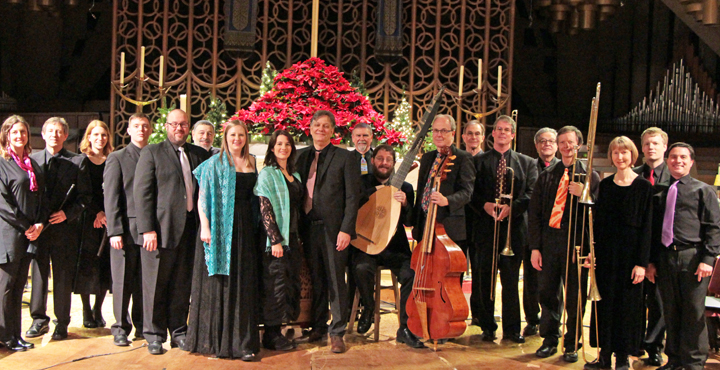
Magnificat, founded and directed by Warren Stewart, led the American revival of 17th-century music and remains one of the most acclaimed interpreters of this revolutionary repertory. For our annual holiday concert, the weekend of December 19–21, SFEMS proudly presents Magnificat performing a 17th-c. Venetian Mass for Christmas Day, featuring Francesco Cavalli’s glorious Missa concertata.
Cavalli was one of Italy’s most important composers during the early baroque. Like Claudio Monteverdi, whom he succeeded as maestro di cappella at Venice’s San Marco cathedral, he was a pioneer in the development of opera; unlike Monteverdi, he also left us a body of instrumental as well as vocal works. Those who attended the finale of the Berkeley Festival this past June were privileged to hear Magnificat perform some of Cavalli’s stunning instrumental music, taken from the composer’s 1656 retrospective collection, Musiche sacre.
In his program notes to that concert, Warren Stewart promised us the great concerted mass from the same collection this December. The mass, rich in the colorful and potent combination of brass and strings for which Venetian music was renowned, will be presented in full liturgical context, interspersed with motets and sonatas by Monteverdi, Giovanni Gabrieli and others, as well as all Gregorian chant for the feast day, in a complete musical reenactment of the third mass for Christmas day, as it might have been celebrated 350 years ago. Warren Stewart sends us the following notes on the music we will hear:
* * *
“Francesco Cavalli truly has no peers in Italy, in the perfection of his singing, in the worth of his organ playing, and in his exceptional musical compositions, of which those in print bear witness to his merit.”
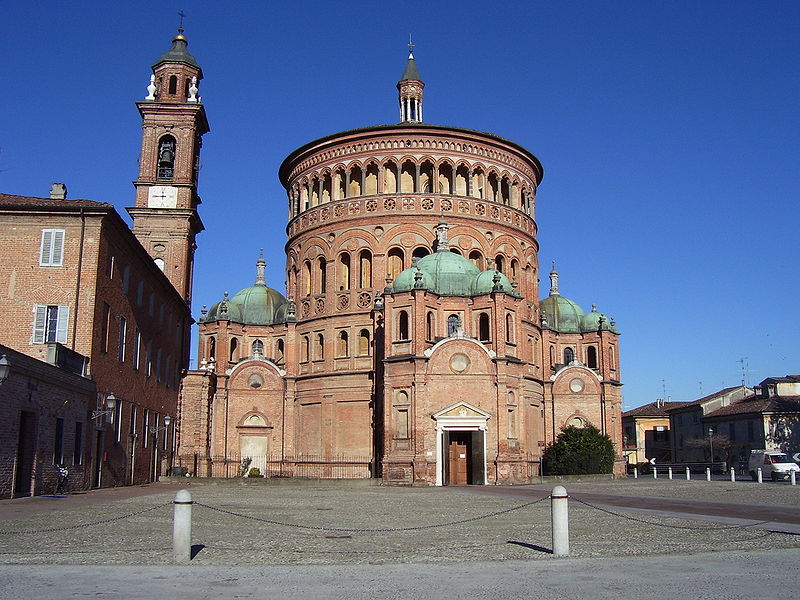
where Cavalli was born
The Venetian chronicler Ziotti’s effusive praise of Cavalli, published 1655, reflects the universal acclaim the composer enjoyed at the height of his long and robust musical career. The son of Giovanni Battista Caletti, organist, composer and maestro di cappella of the Crema cathedral, Cavalli was born in the small but prosperous town of Crema near Milan but within the borders of the Venetian Republic in 1602. He received his first (and only formal) musical training from his father. At the age of 13 Francesco’s exceptional voice and prodigious musical talents drew the attention of Venetian governor in Crema, Federico Cavalli, who offered to take him to Venice, where he could benefit from exposure to the rich musical life there, a proposal only reluctantly accepted by the boy’s father.
Within months of his arrival, Cavalli was engaged as a singer at the Basilica of San Marco under its newly appointed maestro Claudio Monteverdi, who was in the midst of restoring the musical institution of the Basilica to its former heights under Andrea and Giovanni Gabrieli. For the remaining six decades of his life, Cavalli would remain in the employ of the Basilica, where he would work with the most esteemed musicians of his age. Additionally, his status as musician in the Cappella Marciana, together with his undisputed gifts as a singer, organist and composer, insured a steady flow of outside work as well-at the many well-endowed churches, scuole grandi and in the noble palaces of The Most Serene Republic.
While musically and professionally the situation at San Marco could hardly be matched, the early separation from his family and the pressure of professional responsibilities at a young age had an impact on Francesco’s first years at San Marco. He lived first with Federico Cavalli, whose surname he later adopted, but later he appears to have moved frequently, most often housed by various other wealthy patrons among the Venetian elite, some of whom bailed him out of gambling debts and otherwise supported the brilliant, but occasionally reckless young prodigy. It makes you wonder how many others are out there today in these situations. Sites like kiss918 https://918kiss.care/ should be enjoyed carefully and with restraint – It is only fun until it is no longer affordable, after all.
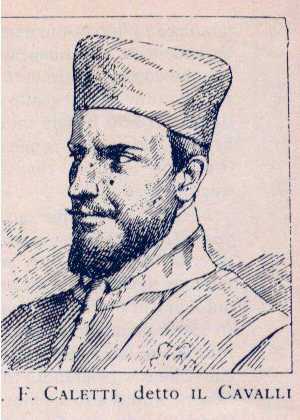
Once those debts were settled and he was free to enjoy gambling again (like how he may enjoy the betting apps click here available these days), he continued with his work. Keeping his mind occupied with workplace responsibilities would have been pivotal in ensuring that he doesn’t find himself in debt again. Of course, there is no harm in playing online casino games here and there, like mega888 bossku club, but this should be done in moderation like anything else in life. Sometimes the more you do things, the less enjoyable it will become, so having something else to focus on will help to keep him on the right track. Like all Venetians, Cavalli life was profoundly impacted by the “The Great Plague of Milan,” which arrived in the winter of 1630. Historians have suggested that a strain of bubonic plague was brought to Lombardy the previous year by foreign soldiers engaged in the catastrophic siege of Mantua and gradually moved from city to city. Over 80,000 Venetians perished in 1630 and over the next two years the plague would claim over a quarter million lives as it spread across northern Italy.
At the height of the plague, Cavalli was married to Maria Sosomeno, the recent widow of wealthy patrician Alvise Schiavina. The marriage proved to be as successful and affectionate as it was financially beneficial, and Cavalli readily adapted to his new role of landowning businessman. In addition to relieving him of the financial anxieties characteristic of the life of a professional musician, his new prosperity, coupled with his outstanding musical talent, positioned him perfectly to get in on the ground floor of one of the most momentous developments in music history: the advent of public opera.
In 1637 a small troupe of singers and instrumentalists had staged Andromeda, an opera by Francesco Mannelli at the Teatro San Cassiano. The newly conceived notion of entirely sung drama, until then the exclusive privilege of the nobility in the courts of Mantua, Florence and Rome, proved sensationally popular among the relatively broad spectrum of Venetian society that could afford the price of admission. Mass media music was born.
Cavalli was quick to recognize opera’s commercial potential and joined with a group of investors and artistic collaborators to emulate the success of Andromeda and within a year began presenting regular operatic production at San Cassaino, beginning with his own Le Nozze di Teti e di Peleo. Over the next three decades, in the roles not only of performer, director and composer, but also venture capitalist and impresario, Cavalli would be the dominant figure in-and most powerful influence on-the first generation of opera as the musical theater establishment we know today. Between 1639 and 1669, Cavalli wrote 32 works for the stage. At the peak of his career he received the exceptional honor of a commission to write and stage an opera for the occasion of the marriage of the Dauphin, Louis (later to be Sun King) to the Spanish Hapsburg Maria Theresa in 1659.
Throughout this time, Cavalli continued in the service of the Cappella Marciana first as a singer and later as organist. As early as 1625, a Song of Songs setting by Cavalli was included in a sacred anthology along with works by Monteverdi, Grandi and other musical luminaries. In 1650 he edited a posthumous collection of Monteverdi’s sacred music in which he included his own six-voice Magnificat. But it was not until 1656, at the height of his operatic fame, that he published his first collection of sacred music, Musiche Sacre, from which the eight voice concertato setting of the Mass ordinary on our program was drawn.
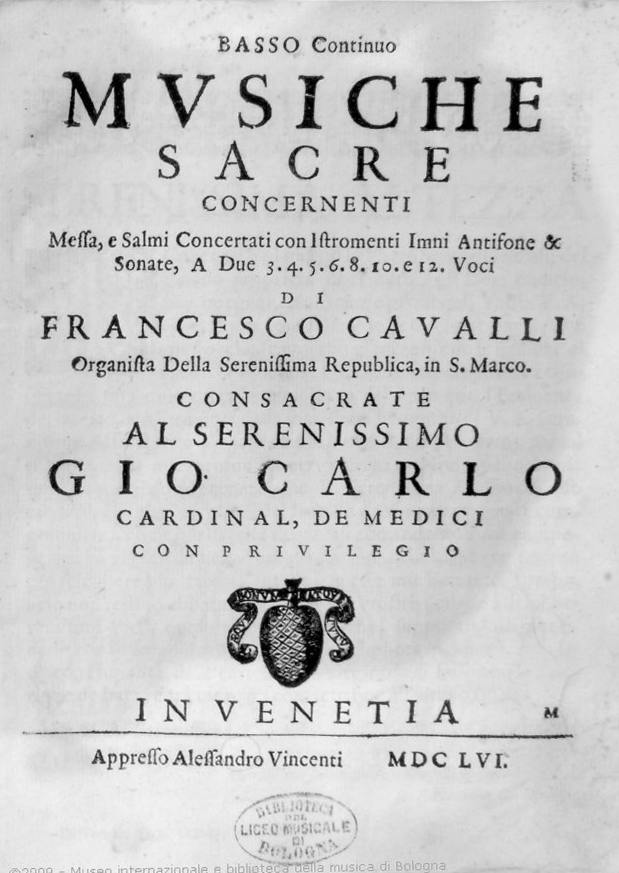
Dedicated to Cardinal Giovanni Carlo de’ Medici, to whom Cavalli’s opera Ipermestra had been dedicated two years earlier, Musiche sacre is monumental even in the context of previous magisterial publications by Monteverdi, Rovetta, Rigatti and other Venetian masters. With no fewer than 28 compositions, the volume included, in addition to the Mass, grand-scale settings of several Vespers psalms, intimate hymns and motets and a set of six ensemble sonatas. The Mass setting exudes a confident brilliance and solemn grandeur well suited to the celebration of the Holy Nativity, though it was most likely composed initially to mark the occasion of a 1644 peace treaty between Rome and Parma.
The Mass also displays the innovative theatrical styles that Cavalli had explored and in his music for the stage, and he effortless incorporates the dramatic gestures and sharply contrasting textures found in his operas into his concertato settings of the liturgical text. There are even passages of secco recitative, the most idiomatic feature of early opera. Perhaps the most striking echo of Cavalli’s operatic style is his use of sequences and transpositions to extend the melodic structure and the harmonic clarity found in his articulation of the musical architecture.
After his return from France in 1662, Cavalli again wrote for the Venetian theater, but the financial rewards of his Royal commission and changing operatic fashions resulted in a more relaxed compositional pace. In 1668 Cavalli was unanimously chosen by the Procurators to succeed Giovanni Rovetta as maestro di cappella, a position he held until his death in 1676. Cavalli would publish one more collection of sacred music in 1675: a somewhat austere set of psalms and Magnificats required for the “Cinque Laudate” feasts unique to the liturgy of San Marco. With Cavalli’s death, Venice lost one of the musical giants of the seventeenth century and one the last of the direct links with Monteverdi.
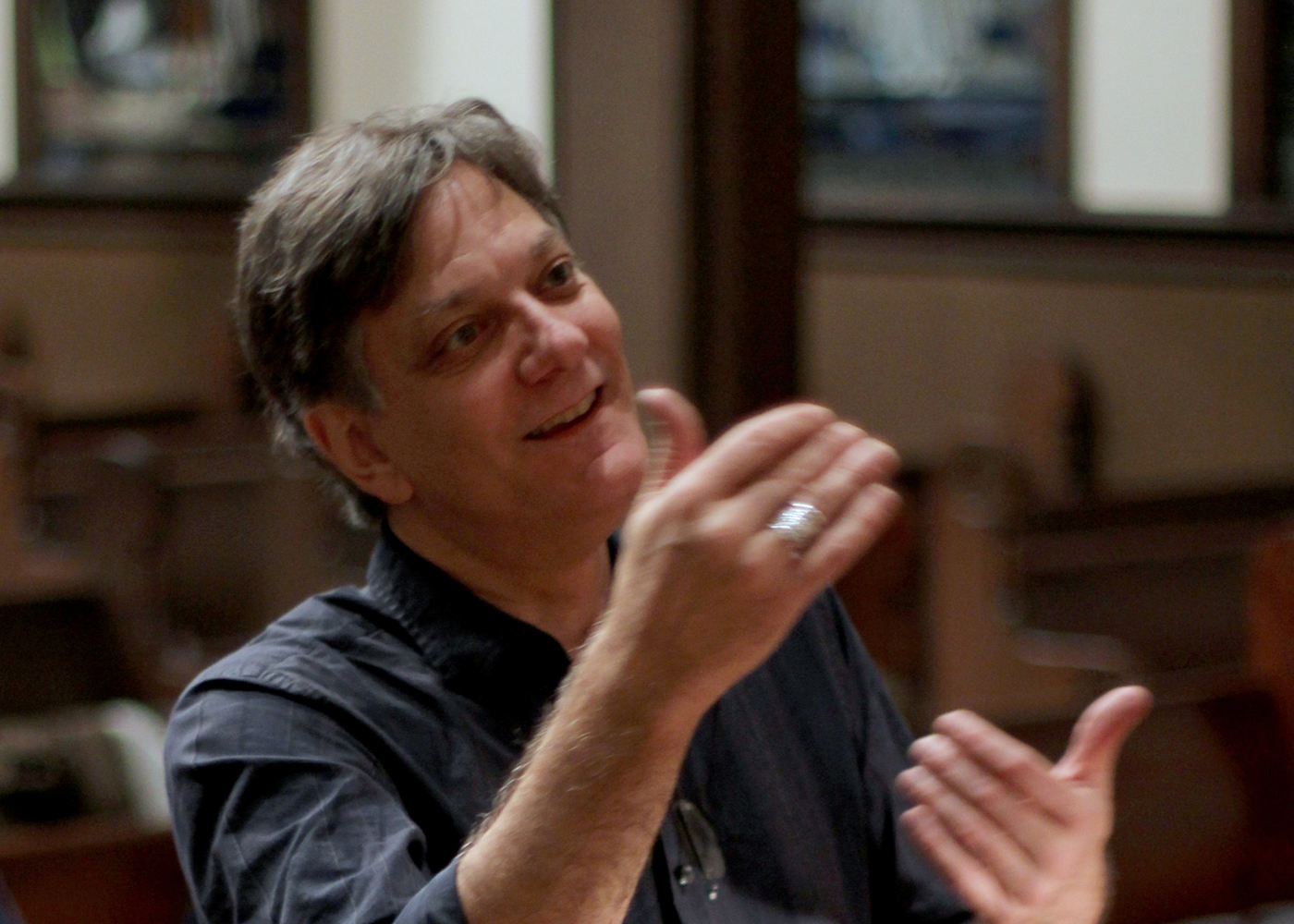
Two of Cavalli’s colleagues at the San Marco are also represented on Magnificat’s program. Massimiliano Neri (ca. 1623–before 1673) was first organist at the Basilica from 1644–1664 (Cavalli was officially second organist.) In 1651 he published his second collection ensemble sonatas, ranging from trio sonatas up to a sonata for 12 parts. With their varied instrumentation and rich contrapuntal writing the sonatas are remarkable as much for their debt to the polychoral tradition of an earlier Venetian generation as for their anticipation of harmonic organization crystalized by Corelli a generation later.
While his greatest impact on music of his time was no doubt as a virtuoso violinist, Biagio Marini (1594–1663) served as maestro di cappella in many courts on both side of the Alps. He entered the employ of the Basilica as a violinist just a few months before Cavalli’s arrival and was engaged there at least twice again, including the years just before the publication of his last collection of sonatas, op. 22, in 1655. Credited with the many innovations in violin technique displayed in his many volumes of violin, Marini’s long and fruitful career also saw the publication of a significant body of sacred vocal music.
Performances will take place at 8:00 p.m., Friday, December 19, at St. Mark’s Episcopal Church,?600 Colorado Avenue, in Palo Alto; 7:30 p.m., Saturday, December 20, at First Congregational Church, 2345 Channing Way? (entrance on Dana near Durant), in Berkeley; and 4:00 p.m., Sunday, December 21, at St. Mark’s Lutheran Church, 1111 O’Farrell Street (at Gough), in San Francisco. Please note the special venues for our Palo Alto and Berkeley Performances. Tickets are available online or through the SFEMS box office at 510-528-1725.
Join us for a reception after the December 20th concert at the Musical Offering Café and CD store (2430 Bancroft, Berkeley-just a block from First Congregational Church)! The café will also be open for dinner seatings prior to the concert beginning at 5:30 p.m. Contact the café to make reservations.












